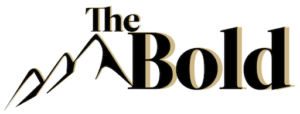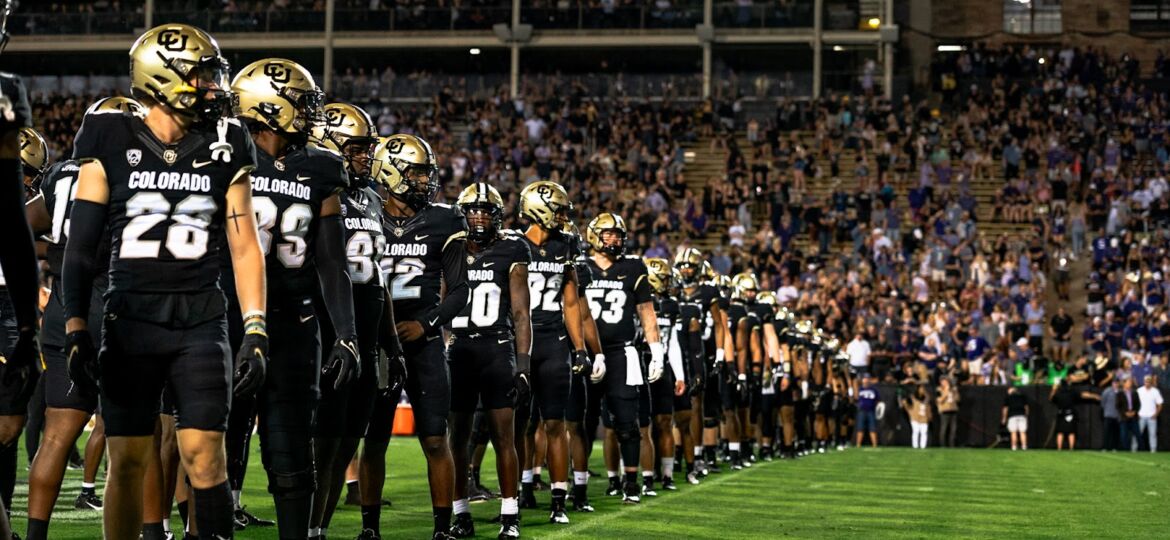
By Troy Finnegan and Noah Anderson
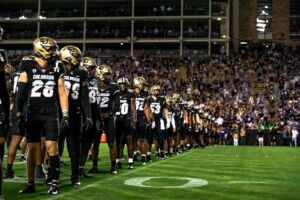
CU student-athletes are learning to navigate the new NIL landscape in college sports (Photo By Nathan Thompson/The Bold)
Whether you hear the loud crack of shoulder pads on Folsom field or the pounding noise of a basketball on the hardwood of the CU Events Center, student-athletes are at CU Boulder using their talents to market themselves to businesses in hopes of securing NIL deals.
Name, image, and likeness have become one of the most talked about aspects of collegiate sports in the past year. Athletes can make money by signing autographs, business ownership/creation, camps and lessons, social media posts and public appearances.
Jake Wiley, a sophomore offensive lineman at CU, said that NIL simply allows student-athletes opportunities to make money while they play collegiately.
“It’s a perfect way for college athletes to make money over their name, image, and likeness like a pro athlete can,” Wiley said. “I feel like every athlete was like, oh, I think I’m going to get this
deal, I’m going to get that deal, they had high hopes, but everyone kind of got grounded after it got launched.”
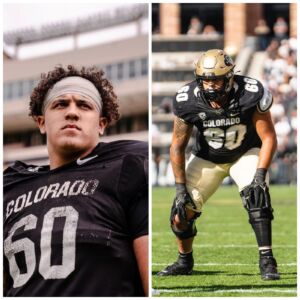
Jake Wiley prepares for his blocking assignment at Folsom Field (Photos courtesy of @jakewiley60 on Instagram)
Wiley partnered with Height Hype, an online platform that allows student-athletes the ability to design custom merchandise and height charts for Buffs fans. He has also been compensated for several events, including a podcast interview and autograph signing.
Wiley said he got paid for being interviewed for 30 minutes. “He paid me some money just to get interviewed, so I thought that was pretty cool.”
Wiley, who has played in 18 career games at CU with 12 starts and led all Buffs’ offensive linemen with 674 offensive snaps in 2021, said that most, if not all, of his NIL ventures have involved posting on his social media accounts.
“The easiest way to show their brand and promote it is through social media. Because everyone has their followers and their following like that, and so they can push it and being an athlete, we have fans that look at it, and it kind of just trickles down like that,” Wiley said. According to Wiley, social media plays a big role in it all.
Sports agents’ influence on NIL
According to Sports Business Journal, about 75% of all NIL activity in college sports comes from social media. Many companies are essentially looking for content creators that will promote them on Instagram or Twitter.
However, many athletes are primarily on their own when it comes to finding NIL deals. Most schools are not negotiating deals with businesses on behalf of their players, and CU does not negotiate on behalf of its athletes at all. All NIL negotiations are strictly between the business and the athlete themselves.
While they don’t negotiate on behalf of their student-athletes, Colorado has followed the steps of many other schools to help out. The Buffs partnered with INFLCR, an app designed to help athletes grow their brand and increase social media following, on a program called Buffs NIL Exchange, a program that helps athletes connect with businesses to facilitate deals. So, while the school doesn’t help negotiate, they have helped get athletes in the room.
The app helps connect athletes with media partners both in their institution and outside, allowing them to easily access stats, highlights, and other things to post to their social media accounts. In addition, they provide athletes with metric-based data that makes it easy to track engagement and follower growth on social media.
Sadie Baker, the Program Manager for Scripps Student-Athlete Leadership and Career Development at CU, helps student-athletes manage their NIL ventures through the Buffs with a Brand Program.
The Program was established to help educate student-athletes on NIL and give them resources to capitalize on their name, image, and likeness. Baker said that currently, the program’s focus is to help student-athletes with their personal engagement and marketing.

Sadie Baker with members of the CU men’s basketball team (Photos courtesy of Sadie Baker)
“Right now our focus is just personal engagement and personal marketing. So really focusing on that personal branding and understanding how you put yourself in the best position,” Baker said.
Baker mentioned that part of the Buffs with a Brand Program involves coaching student-athletes on improving their social media presence.
“We can run a social media analytic click test on them to see their account and it will bring engagement levels up,” Baker said.
Baker wants CU student-athletes to understand that having a polished and professional-looking social media presence can create immense value for them in the NIL space.
“Making sure you know they have a bio that they share with their student athlete on their page (is important),” Baker said. “I would say just really focusing on how you can present yourself, why it’s important to have hashtags, because it draws in a reach.”
Personal brand and self-promotion of that brand, have become paramount for athletes looking to land a large number of NIL deals, which in a way, has left a hole for athletes who aren’t as involved on their social media platforms.
“I’m not a big social media guy. I don’t really have a big social media presence at all, but I’ve had a couple of offers mostly just from food places,” said Lawson Lovering, a former Colorado men’s basketball player who recently transferred to Utah. “It can be hard. I haven’t really been seeking deals out either. I know a lot of guys will seek stuff out, but I really just let everything come to me.”
One of the main benefits businesses profit from in the NIL landscape is promoting their business and/or its products on social media. Athletes with less online following are less ‘valuable’ to them.
A portion of student-athletes around the country are not working alone to secure NIL deals. Like professional sports, athletes at the collegiate level are now using sports agents to help them land more lucrative deals.
“I would say, really when it comes to an agent, you’re only seeing a small percentage having agents. If you’re more of those high-profile athletes where literally deals are getting handed to you and you need someone to help you navigate that space,” Baker said. “It’s hard reading contracts and understanding all that type of language at such a young age.”
These sports managers or agents have become increasingly involved in NIL activities. A sports agent in the NIL space helps student-athletes negotiate deals with businesses and manage their marketing and self-promotion. They can even be involved in helping organize student-athletes finances and public image.
“Our job consists of managing players’ careers, on and off the field to be honest with you,” said Paul Sheehy, the Founder and President of ProStar Sports Agency.
Sheehy and ProStar Sports agency represent eleven student-athletes around the country. They help them with marketing and endorsement opportunities and are responsible for contract negotiations.
Before NIL rules were implemented, ProStar Sports agency had heard that student-athletes could soon profit from their name, image and likeness. So when the rules took effect, ProStar was eager to help student-athletes. ProStar started to prepare for NIL rules about a year in advance and now represents athletes on a selective basis.
“We kind of knew that this was going to come down the pipe at some point, and that players will be offered the opportunity to take advantage of their own name, image, and likeness, which they should never have been prevented from doing in the first place,” Sheehy said.
Part of the criteria to represent a student-athlete is the athlete’s potential and ability to play at the next level. Still, success in a particular sport does not necessarily mean that brands will want to collaborate.
“Certainly we try to look at players who, you know, may have that ability to play at the next level, whenever that time comes,” said Sheehy. “What matters most, is not necessarily statistics on the field, but the statistics for your social media followings and engagements.”
Brands seem to not care as much about an athlete’s success on the field; instead, they only care about how extensive their reach is to their social media followers.
NIL in women’s sports
While NIL managers are doing a great job making life easier for a select few athletes, the management industry in college sports still has a lot of untapped potential that it could find in order to really help the industry explode, and it starts with expanding their reach to women’s sports.
Pay gaps are an issue that has been constantly discussed when it comes to professional sports, and there are reasons for pay gaps in professional sports, but many of those reasons don’t exist when it comes to NIL in college sports.
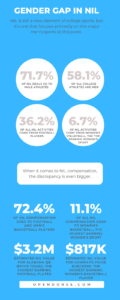
Despite this, NIL deals are still skewed strongly towards men, primarily in the two main college sports, football and men’s basketball. Overall, according to SBNation, 71.7% of NIL deals have gone to men, despite men making up just 58.1% of all college athletes.
When it comes to compensation, the numbers are even more skewed. According to a study by Opendorse, 72.4% of all NIL compensation goes to athletes only in football and men’s basketball.
Women’s basketball represents the third biggest sport in terms of NIL compensation, but comes in at a measly 11.1% on the overall compensation scale, according to Opendorse. Even that number is not necessarily representative of all women’s basketball players, as big stars such as UConn’s Paige Bueckers (who is approaching seven figures in NIL endorsements through deals with StockX and Gatorade) and Iowa’s Caitlin Clark, who is one of the few college athletes working with Nike.
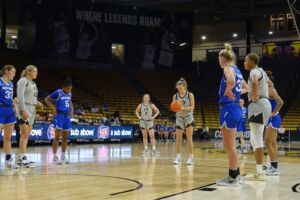
Kindyll Wetta goes through her routine before a free throw vs. Air Force (Photo By Troy Finnegan/The Bold)
“Even on the INFLCR app, some (companies) will be like, ‘for football players or men’s basketball players,’” said Kindyll Wetta, a sophomore guard on the Colorado women’s basketball team.
NIL is not the only aspect of college sports where gender equality has been a hot topic in recent years. The weight room debacle at the 2021 NCAA Tournament brought gender equity in college sports to the forefront of discussion, and that dialogue has kickstarted growth in the popularity and recognition of women’s sports, and some think that that will be enough to rectify the NIL compensation gap in the near future.
“Women’s sports are a beautiful thing, and I think more people are starting to respect women’s sports,” said CU women’s basketball point guard Jaylyn Sherrod. “But at the same time, it’s a growing process. I mean, I like to see that there’s a lot of women’s basketball players that have signed with Jordan and Nike and stuff like that, so I think it’s growing.”
Currently, there is really only a big enough market for NIL managers in the two primary sports getting NIL attention: football and men’s basketball. Apart from the select few women’s hoopers mentioned above, the NIl industry in women’s sports doesn’t warrant the services of managers, but closing the gender gap in NIL and increasing the presence and necessity of NIL managers in women’s sports could go hand in hand.
Increasing stock in women’s sports is just one way that both NIL and the sports agent industry can grow. After all, it is still a new element of college sports that everyone is still understanding and getting involved in. Through support from people like Baker and Sheehy, the agency business in college sports is just beginning to take off.

